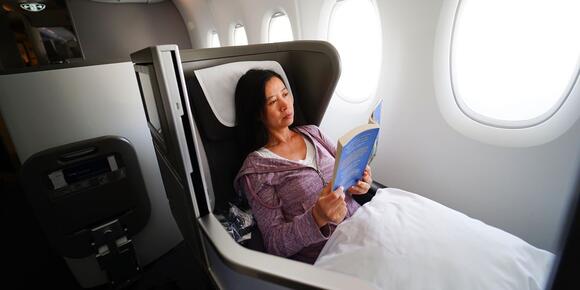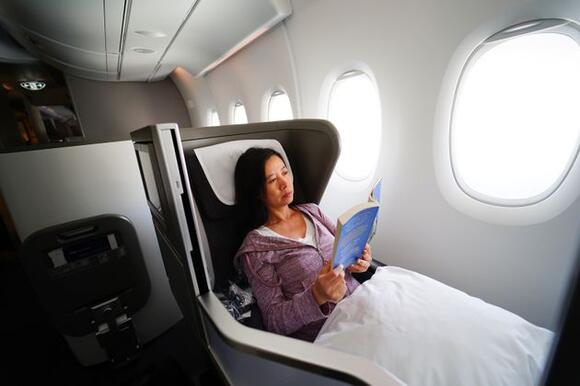
Air travel is a luxury many of us enjoy ― but one common gripe is how cold it can get while you’re on the plane.
Even after putting on the sweatshirt you packed in your carry-on bag and turning off the air vent above you, the temperature on your plane may still feel chilly, especially once you’re in the air. So why does this happen? There are a few reasons ― and some of them are actually intentional.
“There is … a science behind the cold cabin, and it’s [often] for your benefit,” said Jay Robert , a senior international cabin crew member, former flight attendant and creator of A Fly Guy’s Cabin Crew Lounge .
We talked to travel experts about how temperature is controlled throughout the aircraft, why the cabin often feels cooler once the plane is in flight, and tips for staying comfortable.
How is the temperature controlled on the airplane?
When your plane is at the gate, there is usually an external air conditioner, which you may have noticed as “big yellow tubes connected to the plane,” Robert said.
An auxiliary power unit, a small engine located in the tail of the aircraft, is also used to try to cool a hot cabin when the plane is on the ground. When you’re in the air, most planes have a cooling system that works when the engine is on.
Generally, once you’re in flight, “pilots control the master thermostat, and then the crew in the cabin can move that up or down slightly using their cabin control system,” Robert said, adding, “If we need to make a significant change, we must call the pilots and ask them to do it.”
While many airlines have set cabin temperature policies, there is currently no federal regulation for cabin temperature, according to Taylor Garland, spokesperson for the Association of Flight Attendants. The AFA submitted a petition in 2018 to the Department of Transportation for a cabin temperature standard. The DOT is still studying if standards should be set for cabin temperatures, according to The New York Times .

There are health and safety reasons why the cabin is kept at a chillier temperature.
Why can it feel cold once you’re in the air?
First of all, the temperature inside an airplane is controlled by zones, which vary by aircraft type and size, Garland explained.
“It’s an imperfect science,” she said. “If a zone is large and/or the temperature sensor is near a source of heat — just like if the thermostat at home is near a heating vent — then the system will think that the cabin is warmer than it is.”
This could cause the cooling system to turn up higher than it needs to, which can make that particular zone feel cold. That said, it’s important to remember that once the plane is in the air, the outside temperature can be about minus 60 degrees Fahrenheit.
“[The] aircraft … [does] a pretty decent job in flight of keeping the temperature reasonable, with the exception of seats near doors,” Garland said.
Beyond this, Robert shared that the cool cabin temperature once you’re airborne is usually purposeful and beneficial to passengers and crew members.
“We know it’s cold … but we also know what happens when the cabin is too warm, and that is a lot harder to manage than a cold cabin,” he said.
For instance, high cabin temperatures combined with cabin pressure can contribute to fainting, according to researchers from ASTM International .
“I used to work on the largest commercial aircraft in the world that seated over 600 passengers, and one of the things I regularly checked was that the temperature did not exceed 73 degrees,” Robert said. “Sometimes, I would have two or three faintings on a flight, and I would call the front to check the temperature — it was 75 or higher every time.”
Additionally, the cabin air can already be very dry and dehydrating, according to the Cleveland Clinic . And when we’re hot, we lose liquids even faster, Robert explained.
“A cold cabin helps counteract the dry air from taking a worse toll on your body,” he said.
Also, higher temperatures can make odors smell even stronger, and unpleasant odors are inevitable in a crowded cabin, whether someone near you is eating a tuna sandwich or your neighbor takes off their sweaty shoes.
“Warmer temperatures increase the amount of energy available for odor-causing molecules, which means warmer cabins also smell funkier,” Robert said.
Thankfully, there are tips you can try to stay more comfortable on a colder flight.
“Always wear layers so you can have your own personal temperature control,” Robert said.
As an example, he noted how a pullover sweater is a part of a flight attendant’s uniform because it’s expected that cabin temperatures may get cold. He also recommended passengers keep a lightweight sweater in their carry-on, wear socks and bring extra water.
Even if you’re flying to a warm and tropical place, don’t forget to come prepared for the varying temperatures on the plane.
Robert summed it up well: “One of the biggest mistakes … is dressing for the destination instead of the travel that gets [you] there.”
 Most Popular
Most Popular
 There are health and safety reasons why the cabin is kept at a chillier temperature.
There are health and safety reasons why the cabin is kept at a chillier temperature. 
Comments / 0